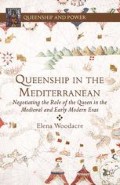Abstract
The marital and political career of Blanca I of Navarre in the first half of the fifteenth century demonstrates a significant shift in Navarrese foreign policy and the importance of establishing a connection between the Pyrenees and the Mediterranean. Previously the rulers of Navarre had focused their alliances to the North; the House of Champagne, which obtained the Navarrese throne in 1234 and the Capetian and Evreux dynasties that followed had all emphasized French connections in their matrimonial political strategies. The result of this approach was that between 1234 and 1387, none of the rulers of Navarre had an Iberian spouse. However, Blanca’s marriages signaled a period of re-Iberianization for Navarre and a deepening connection with Aragon and its Mediterranean empire, which would dominate Navarrese politics for the greater part of the fifteenth century.
Access this chapter
Tax calculation will be finalised at checkout
Purchases are for personal use only
Preview
Unable to display preview. Download preview PDF.
Bibliography
Documents from the Archivo General de Navarra (AGN).
Bisson, Thomas N., The Medieval Crown of Aragon; A Short History (Oxford: Clarendon Press, 1986).
Castro Alava, José Ramón, Carlos III el Noble; Rey de Navarra (Pamplona: Principe de Viana, 1967).
Corrao, Pietro, Governare un Regno; Potere, Società e Istituzioni in Sicilia Fra Trecento e Quattrocento (Napoli: Liguori, 1991).
Diago Hernando, Máximo, “Política y guerra en la frontera castellano-navarra durante la época Trastamara,” Principe de Viana 55 (1994), 527–50.
Earenfight, Theresa, “Absent Kings: Queens as Political Partners in the Medieval Crown of Aragon” in Queenship and Political Power in Medieval and Early Modern Spain, ed. by Theresa Earenfight (Aldershot: Ashgate, 2005), 33–54.
Fodale, Salvatore, “Blanca de Navarra y el gobierno de Sicilia,” Principe de Viana, 60 (1999), 311–22.
Froissart, Jean, Chronicles, trans. and ed. by Geoffrey Brereton (London: Penguin Classics, 1978).
Lalinde Abadia, Jesus, “Virreyes y lugartentientes medievales en la corona de Aragon,” Cuadernos de Historia de España XXXI–XXXII (1960), 98–172.
Lo Forte Scirpo, Maria Rita, “La questione dotale nelle nozze siciliane di Bianca,” Principe de Viana 60, no. 217 (1999), 277–92.
Mainenti, Fernando, “Bernardo Cabrera, Conte sovrano di Modica,” Storia di Sicilia, VIII (2002), 24–29.
Mayer, Hans Eberard, “The Succession to Baldwin II of Jerusalem: English Impact on the East,” Dumbarton Oaks Papers 39 (1985), 139–147.
Meyers, Alec Reginald, Crown, Household, and Parliament in Fifteenth Century England (London: Hambledon Continuum, 1985).
Ramírez Vaquero, Eloisa, Blanca y Juan II (Pamplona: Editorial Mintzoa, 2003).
Ramírez Vaquero, Eloísa, Carlos III: rey de Navarra, principe de sangre Valois (1387–1425) (Gijón: Ediciones Trea, 2007).
Reglá Campistol, J., “La cuestion de los Pirineos a commienzos de la edad moderna: El intento imperialista de Gaston de Foix,” in Relaciones Internacionales de España con Francia e Italia, ed. Jaime Vicens Vives, Estudios de Historia Moderna (Barcelona: Ariel S.L., 1951), 1–31.
Rohricht, R. (ed.), Regesta Regni Hierosolymitani MXCVII–MCCXCI (Vols. I & II) (New York: B. Franklin, reprinted edition, 1960, originally published 1893–1904).
Ryder, Alan, Alfonso the Magnanimous; King of Aragon, Naples and Sicily, 1396–1458 (Oxford: Clarendon Press, 1990).
Sánchez Bella, Ismael (ed.), El Fuero Reducido de Navarra (Edición crítica y Estudios), 2 vols., vol. II (Pamplona: Gobierno de Navarra, 1989).
Sciascia, Laura “Le ossa di Bianca di Navarra: ancora l’eros come metafora del potere,” Quaderni Medievali 43 (1997), 120–34.
Sciascia, Laura, “Bianca de Navarra, l’ultima regina: Storia al femminile della monarchia siciliana,” Principe de Viana, 60 (1999), 293–310.
Sesma Muñoz, J. Ángel, “La reina doña Blanca y Aragón,” Principe de Viana, 60 (1999), 35–48.
Silleras-Fernández, Núria, “Negocios familiares: Relaciones e intercambios entre las cortes de Sicilia y Aragon (1392–1410)” In Actes de XVIII Congrés Internacional d’Historia de la corona d’Aragó, ed. R. Narbona Vizcaíno (Valencia: University of Valencia Press, 2005), 511–22.
Silleras-Fernández, Núria, “Spirit and Force: Politics, Public and Private in the Reign of Maria de Luna (1396–1406)” in Queenship and Political Power in Medieval and Early Modern Spain, ed. by Theresa Earenfight (Aldershot: Ashgate, 2005), 78–90.
Silleras-Fernandez, Núria Power, Piety and Patronage in Late Medieval Queenship; Maria de Luna (London: Palgrave Macmillan, 2008).
Tramontana, Salvatore, “Il matrimonio con Martino: il progetto, i capitoli, la festa,” Principe de Viana, 60 (1999), 13–24.
Trasselli, Carmelo, “Su le finanze siciliane da Bianca ai Vicere” in Mediterraneo e Sicilia all’inizio dell’Epoca Moderna (Cosenza: Pellegrini, 1977).
Tucoo-Chala, Pierre, “L’histoire tragique d’un couple au XIVe siecle: Agnès de Navarre et Gaston Fèbus,” Principe de Viana Anejo 2–3 (1986), 741–754.
Jaime Vicens Vives, Juan II de Aragón (1398–1479). Monarquía y revolución en la España del siglo XV (Barcelona: Editorial Teide, 1953).
Jerónimo Zurita, Anales de la Corona de Aragon, ed. Ángel Canellas López, 9 vols. (Zaragoza: Institución Fernando el Católico, 1980–90), Vol. 5.
Jerónimo Zurita, Indices de las Gestas de los Reyes de Aragon desde comienzos del reinado al año 1410 (Zaragoza: Instiución Fernando el Catolico, 1984).
Editor information
Copyright information
© 2013 Elena Woodacre
About this chapter
Cite this chapter
Woodacre, E. (2013). Blanca, Queen of Sicily and Queen of Navarre: Connecting the Pyrenees and the Mediterranean via an Aragonese Alliance. In: Woodacre, E. (eds) Queenship in the Mediterranean. Queenship and Power. Palgrave Macmillan, New York. https://doi.org/10.1057/9781137362834_11
Download citation
DOI: https://doi.org/10.1057/9781137362834_11
Publisher Name: Palgrave Macmillan, New York
Print ISBN: 978-1-349-47278-9
Online ISBN: 978-1-137-36283-4
eBook Packages: Palgrave History CollectionHistory (R0)

